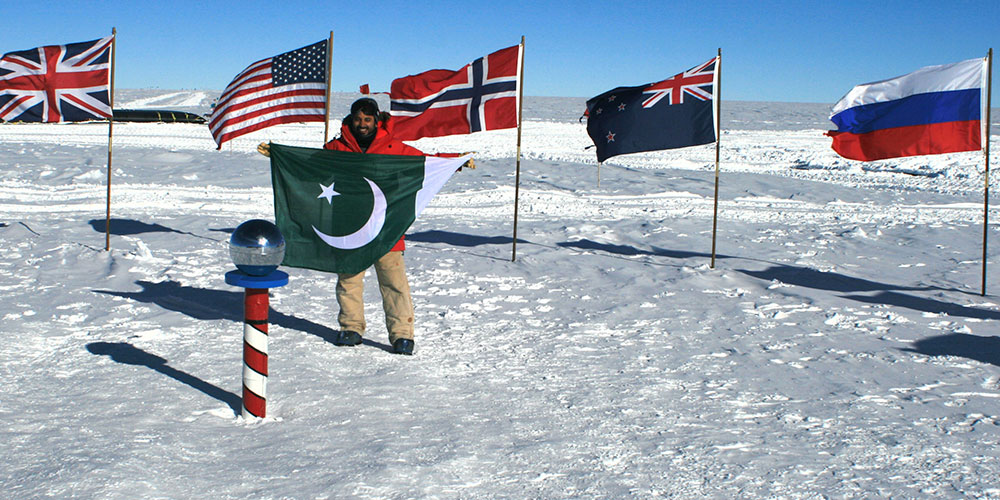THREADS OF SUCCESS
- 06 Apr - 12 Apr, 2024
When MAG contacted the young Pakistani scientist Uzair Latif in mid-November, he was in Christchurch, New Zealand, waiting to board a flight to the South Pole, which was being delayed since two days due to unpredictable weather patterns. Latif, a PhD student at the University of Kansas-Lawrence works in Dr Dave Besson’s group which focuses on Astroparticle Physics. The purpose of his travelling to the United States Amundsen-Scott South Pole Station is for the Askaryan Radio Array (ARA) experiment. Holding a BSc in Physics from the Lahore University of Management Sciences (LUMS), Latif has a lot of doctors in his family, but he is the first one to have a pure science degree. The young fantasizer of space made his dream come true by jetting off to the southernmost point of the surface of the earth. Excerpts:

Can you share a bit about your project with us?
I am working for the Askaryan Radio Array (ARA) experiment that is still under construction at the South Pole. The purpose of this experiment is to detect extremely high energy neutrinos (a type of particle) that come from outside our galaxy. We basically want to understand where these particles come from and the process/es that makes them. The experiment detects neutrinos when they reach Earth and collide with an ice molecule inside the Antarctic Ice Sheet. It creates an explosion which inspires a shower of a variety of different particles and radiations. Our detectors (or basically antennas) inside the ice detect the radio waves in this shower and then we use them to derive some information about the neutrino itself, like the energy with which it collided and the direction it came from.
What sparked your interest in this experiment?
I had been interested in astrophysics and astronomy since my teenage and wanted to do something related to stars or cosmos. In LUMS (from where I did my BSc in Physics), I got a taste of numerous fields of Physics and I did my final year undergrad project in Astroparticle Physics. I loved working on it and when I applied to graduate schools for my PhD in the US, I also applied to universities where I knew professors were working on projects in this field. So, when I finally got enrolled in KU-Laurance, I decided to work on this experiment with my PhD supervisor.
Are you the first Pakistani to work in the South Pole?
I have heard of other Pakistanis who have been to the South Pole, so I am definitely not the first one. I may be the first physicist who has been there under the USAP (US Antarctic Program). However, I have not been able to verify this piece of information yet.
How many members are there in your team? In what capacity will you be working as?
ARA is a collaboration of lots of people working in various universities around the world. At the South Pole, my primary job as part of the ARA drill team is to help drill holes with a diameter that is the same as the width of my hand and around 200m in depth. The ARA drill team mainly comprises of five people including myself. The other four people are: James Roth (University of Delaware-Newark), Terry Benson (University of Wisconsin-Madison), Rob Young (KU-Lawrence) and Thomas Meures (University of Wisconsin-Madison).
As a child, did you ever dream of going to the South Pole?
I always wanted to travel as a child. During my undergrad I became a part of the LUMS Adventure Society with which I saw a large part of Pakistan's northern areas and got addicted to trekking and camping. At that time, South Pole was just a wild dream. It seems surreal now that it is finally coming true.
Can you share details about your project that could help our readers understand your research better?
My PhD thesis is based on ARA. My work on the South Pole is for ARA but is not directly related to my thesis. As a part of my thesis, I am trying to understand all the other different particles that my experiment would find, other than neutrinos, so we can develop better analysis tools to distinguish neutrinos from the rest of them.
What inspired you to follow this path?
I was always awestruck and fascinated by space itself. I have also been inspired by Dr Abdus Salam and his fundamental contributions to particle physics. I aspire to contribute to Pakistan’s scientific scene like him and I really hope he gets the recognition he deserves in Pakistan for his scientific achievements.
How prepared are you for the South Pole?
I had to go through many blood tests and general physical health checkups so that I could be deemed fit to go the South Pole. I did a lot of swimming and other exercises as well which helped me in cardio workout. I hope it helps me tackle low oxygen levels at the South Pole.
What does your gear carry?
It includes snow shoes, windbreaker jackets, balaclava masks, neck gaiters, gloves, goggles and bib overalls.
COMMENTS